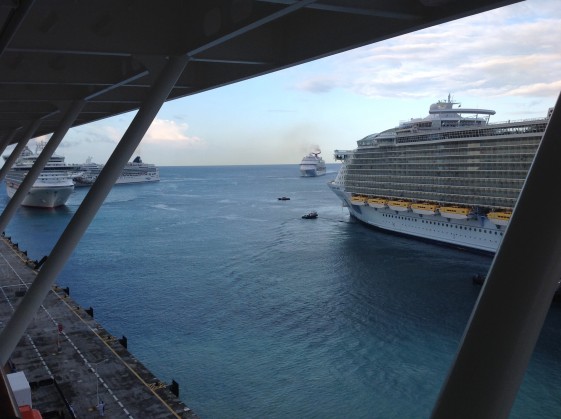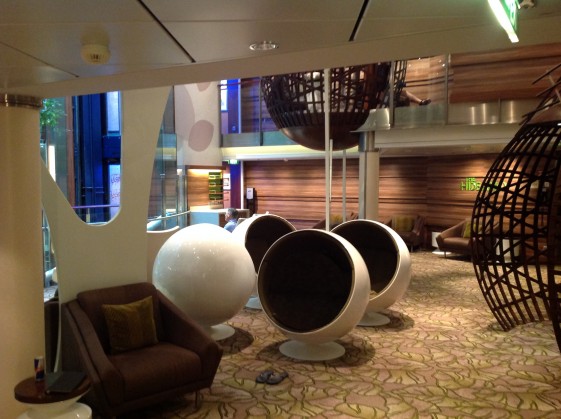For our vacation a few weeks ago, we took a cruise in the Caribbean. The ship was one of the larger ones in service, with thousands of guests, thousands of crew members, and a daily activity list that took over a full page.
Large cruise ships are like floating cities — just better managed. The complexity of the endeavor is almost hard to fathom, and cruise lines understand that their competitive advantage lies in creating memorable and unique customer experiences.

Cruise ship traffic jam in St. Maarten
Of course, the cruise lines sell products, excursions, drinks, and a host of other items, but none of those individually are why people go on cruises. The experience of cruising is the product, and it had better deliver across the board.
With such a focus on creating great experiences, I was able to find a number of customer experience lessons in my recent voyage.
11 Customer Experience Lessons from the Cruise Industry
1. Learn to Do More with Less
Cruise lines, like many organizations, are learning to do more with less. The “orchestra” in many cases was a three or five piece band, and they were able to create grand showstopping music using a handful of live musicians and pre-recorded tracks. (My father and I are musicians, so we noticed, but it is doubtful many people did.)
Also, musicians did multiple duty, moving from bar to lounge to theater. The wait staff was similarly shuffled, moving from restaurant to restaurant, working a breakfast shift at one, a lunch shift at another.
2. Maintain Your Ship
From the moment they go to sea, all ships are in a race against time. The merciless pounding of waves, the never-ending deterioration from salt, and the wear and tear that comes from constant use means that every ship will eventually wear down. That is why cruise lines obsessively maintain their ships. Ships are washed constantly, repainted regularly, and overhauled at specific intervals.
Doing business might not be as unforgiving as sailing the seas, but it wears our organizations down too. Computers need optimizing, storefronts need refreshing, and employees need retraining.
3. Sometimes the Customer’s Safety Comes Before the Customer’s Happiness
Every organization has safety, liability and regulatory concerns with which to contend. Obviously, on a cruise ship, safety is paramount and, at times, must supersede the customer’s happiness. The takeaway is how focused cruise lines are on making sure that safety impinges upon the guest experience as little as possible.
4. Complexity Is Difficult to Manage and Customers Do Not Care
Coming from a business frame of mind, one can not help but be impressed by the operational complexity of running a major cruise ship. However, from the conversations we overheard on our voyage, most customers are not impressed. They paid for a certain experience and do not care how complicated or challenging it is to deliver it.
Judging from some of the conversations we overheard on board, cruise customers are a pretty tough bunch with exceptionally unforgiving standards. Yet, the lesson is applicable across all industries. Customers care about their experiences not your excuses.
5. The “10 & 5? Rule Still Works
The 10 & 5 rule has been around forever. If you are with ten feet, you acknowledge the customer with a smile. If you are within five feet, you acknowledge the customer verbally. 10 & 5 was alive and well on our cruise. I do not think we encountered a staff member in an elevator or hallway who did not smile and inquire about our day.
6. If You Offer Something for Everyone, Have Something for Everyone
If variety of experience is your offering, then it is essential to do it right. Some business models focus on doing a few things very well. Five Guys Burger and Fries for instance. Others focus on being one stop shops. Wal-Mart for example. If you offer a variety of experience, then you had better have that variety.
Our cruise had a dizzying array of activities scheduled each day. Whether it was food, entertainment, or activities, the ship presented a wealth of options and, truly, something for everyone.
7. Effective Design Is Paramount
One of the reasons this cruise was able to be more lightly staffed in certain areas was that the ship was newer and was on the cutting edge of delivering great experiences through efficient design and effective systems.

The Hideaway. A cool place to read and relax away from the activity of the pool deck.
8. Bad Actors Are Part of the Territory, Everywhere
In one of the restaurants on board, the waiter came over to us at the end of the meal and told us that if we were going to leave a tip not to bother, it went straight to the ship. This sounded deceptive on the ship’s part, so we left him cash. Thinking about it later, I got suspicious. On another visit to the same restaurant, I asked the manager about the tips. He said they did not go to the ship but were pooled among the wait staff. The waiter had played us and stolen from his fellow team members in the process.
In any business, you will have to deal with bad actors taking advantage of your employees and customers. Have the controls and culture in place to minimize the impact.
9. Anticipate Questions and Answer Them in Advance
Speaking of tips, this cruise was setup differently than the traditional cruise, where tipping protocols are fairly standardized. Communication on tipping in this changed model was scarce, and we had to seek out counsel on the last day of the cruise. Similarly, information on mobile phone access was extremely hard to come by.
We cannot have been the only people to want to know these things, but the cruise line did not do a good job of anticipating these rather obvious questions. Our experience could have been improved if it had.
10. Nail the Big Moments
When your customer experience is complex, involving hundreds of different touchpoints, you are well-advised to nail the big moments first. Find the experience drivers that most impact the customer experience and focus your efforts there. Aside from the ship itself, the primary experience drivers on a cruise are usually the entertainment and the food. Nail the dining and the shows, and you can get a little leeway elsewhere.
11. Separate Onstage from Offstage
Thousands of people are all crammed in a single floating spot on the ocean, and the staff has the challenging job of making what they do as invisible as possible to the guests. Obviously, not everything can be hidden from guests in such tight quarters. Sometimes a back hallway is not available to get a supply cart from A to B, and it has to go through the main hallway with the guest. However, our ship’s architect and our ship’s staff did an admirable job of hiding the work of the ship from the guests, of keeping onstage and offstage (to use the Disney paradigm) as separate as possible.
_________
Great cruise ships understand the importance of great customer experiences. From the simple attentiveness of the staff to the broadway-esque shows of the main theater, cruise lines understand that the experience is their product and that they have to provide value at every turn to make cruising more attractive than going straight to a destination.
How many of these 11 lessons can work in your organization?



